These Chicagoland restaurants are using ingenious cooking techniques to do everything they can to make sure not one scrap of food goes to waste that doesn’t need to. Here are nine delicious dishes you can feel great about ordering.
El Che Steakhouse & Bar
845 W. Washington Blvd., Chicago, 312-265-1130
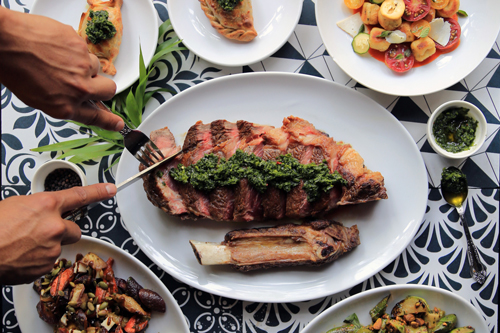
At Argentine steakhouse El Che Bar, the steaks taste extra delicious because Chef John Manion bastes them all in beef butter. Manion takes all the fat trimmings and caps from the beef they butcher, renders, strains, and cools it, and then whips it with garlic and salt. “It’s an effort to provide zero waste with our beef while also enhancing the flavor of all our steaks,” he says. Choose from a 10 ounce sirloin cap ($32), 8 ounce filet mignon ($49) with mustard sauce, or the 32 ounce bone-in ribeye ($79). There’s also a chef’s counter tour de beef ($85/person) tasting menu available Monday through Wednesday for two diners, offering an intimate front-row glimpse at El Che’s open hearth cooking.
Funkenhausen
1709 W. Chicago Ave., Chicago, 312-929-4727

The sturgeon pastrami ($13) at Funkenhausen in West Town is a pescatarian version of one of Chef Mark Steuer‘s favorite sandwiches — the Reuben. He rubs the sturgeon with black pepper and coriander before brining it for two days, then smoking it. “Sturgeon has a high oil content, so it stays very moist and flavorful after being smoked,” he says. He then adds a crunchy twist with crispy fish skin, dehydrated overnight, then fried and seasoned with flavors of rye bread. “Most people throw the skin away, but we figured out how to turn it into chicharrón,” Steuer says. “Because of the oil content of the skins, they will actually puff into chicharrón like pork skins do.”
NoMI
800 N. Michigan Ave., Chicago, 312-239-4030
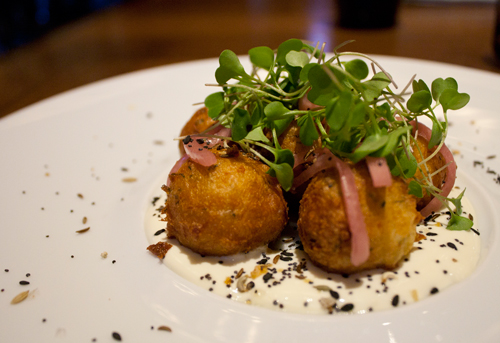
At this elegant restaurant overlooking the Magnificent Mile, Executive Chef Eric Damidot sources whole Skuna Bay Salmon, fileting the fish for a salmon entrée ($37), then curing and smoking the scraps to fill his smoked salmon beignets ($18), served with herb cream cheese and pickled red onion. It’s Damidot’s spin on classic French Haitian accra fritters. They then recycle the bones in an ORCA compost machine, which digests food waste into a liquid that is then captured or repurposed by wastewater treatment facilities. “It helps us reduce environmental impact,” Damidot says. “There are no gas emissions from recycling on-site and no truck traffic needed to pick up waste.”
Daisies
2523 N. Milwaukee Ave., Chicago, 773-661-1671
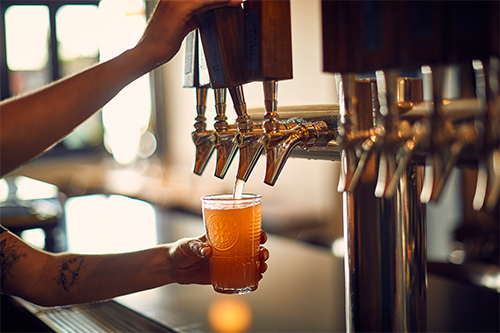
At Daisies, there’s an emphasis on using local ingredients and re-using ingredients whenever possible to ensure no food is wasted, including using leftover wine from glass pours on Sunday nights to make vinegar. Chef Joe Frillman sources “ugly” fruit from local farmers to flavor housemade kombucha ($5), and Daisies also has a sipping vinegar on draft ($6) made from 200 gallons of Klug Farm apple cider that had started fermenting because the apples were too warm when pressed.
Temporis
933 N. Ashland Ave., Chicago, 773-697-4961
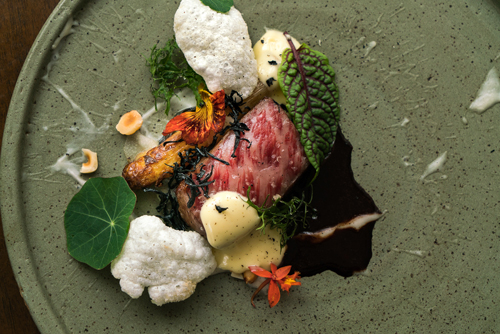
At this intimate 20-seat restaurant, Executive Chef Donald Young tries to make use of every last bit of product through fermentation and preservation. New on the spring menu, the A5 Miyazaki wagyu with French white asparagus is a prime example. Young ferments the woody ends and tougher outer peel of the asparagus, then cooks it in cream and purées it to make an asparagus pudding. He also renders wagyu scrap and uses the extra fat to cook the asparagus, fry and sautée black trumpet mushrooms, and make yeasted beef hollandaise. Asparagus vinegar made the previous year offers an acidic punch to cut through the rich flavors. The 11-course tasting menu is $125 with optional wine pairings for $95 and $165.
Bistronomic
840 N. Wabash Ave., Chicago, 312-944-8400
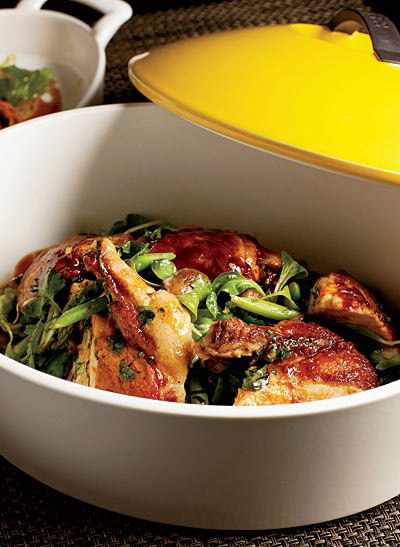
Chef Martial Noguier has an old-school French philosophy when it comes to food, including using every part of the animal in his cooking. He sources whole organic Amish chickens from Miller Farms in Orland, Indiana, and goes through 48 to 60 birds a week. Chicken breast and thighs are used in a dinner entree ($22.50) served with onion purée, seasonal mushrooms, and glazed turnips, while legs are used in the chicken and mushroom crepe ($13.95) served at brunch. A chicken and waffles brunch special features chicken wings ($13.95) and Noguier uses chicken liver to make a housemade chicken liver mousse ($10.95) served with apple arugula salad and roasted hazelnuts. Naturally, the chicken bones are used to make chicken stock as a base for soups and sauces.
Cafe Robey
1616 N. Milwaukee Ave., Chicago, 872-315-3084

“Going full board no waste is my end goal, but it is very difficult to use everything that we bring in house,” says Executive Chef Kevin McAllister. “We are constantly trying to reuse scraps and trimmings, making scraps from dinner prep into brunch as well as brunch prep into dinner dishes.” For example, beetroots are used in a beet salad ($10) served at dinner, and the tops are used for the braised greens on the biscuits and gravy ($12) for brunch.
Dusek’s Board & Beer
1227 W. 18th St., Chicago, 312-526-3851
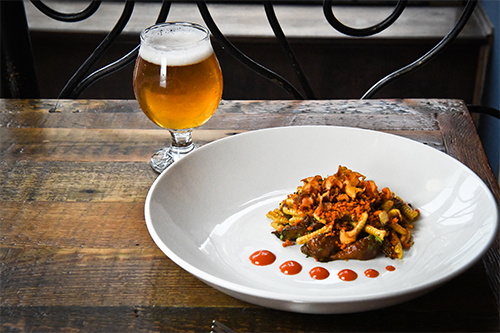
Bugs Bunny would approve of the carrot cavatelli ($14-18) at this Pilsen brewpub. Executive Chef Mike Galen cooks thumbelina carrots in carrot juice, thyme, and garlic and fresh carrot juice is the base for the pasta sauce. “We take the pulp leftover from juicing and dehydrate it into crumbs,” he explains. The crumbs are tossed with olive oil, carrot tops, and herbs to make a crunchy gremolata garnish. And any leftover carrot pulp flavors a compound butter that finishes the sauce for this inventive ode to carrots.
Cindy’s
12 S. Michigan Ave., Chicago, 312-792-3502
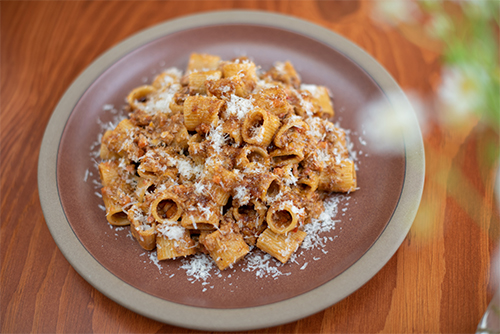
Chef Keith Potter receives whole goats from Kilgus Farm in Illinois each week and teaches his staff how to butcher the animal. The offal, belly, shoulders, and hind quarters are ground to make a sauce for goat bolognese ($22-40) while the shanks and bones become the stock for the pasta pick-up. The loins are cured and smoked for menu features each Thursday evening. “The idea for this particular dish was to offer a savory and hearty bolognese with a whole animal as the base,” Potter says. “With a slightly grassy and gamey flavor, goat is a delicious addition to the menu and is a small enough animal that we can manage one per week.”
 Amber Gibson spends 340 nights a year in hotels searching for the latest and greatest in the travel industry. Her writing and photographs have appeared in print, online, and on the radio for outlets including Four Seasons Magazine, NPR, Saveur, Departures, Rhapsody, Hemispheres, American Way, Private Air, Wine Folly, Plate, Chicago Magazine, Tasting Table, and Serious Eats. She graduated as valedictorian from Northwestern University’s Medill School of Journalism and received a fellowship to attend the 2017 Wine Writers Symposium at Meadowood Napa Valley. Champagne, dark chocolate, and gelato are her biggest weaknesses. She also admires and supports CAASE in Chicago. Follow her adventures on Instagram and Twitter.
Amber Gibson spends 340 nights a year in hotels searching for the latest and greatest in the travel industry. Her writing and photographs have appeared in print, online, and on the radio for outlets including Four Seasons Magazine, NPR, Saveur, Departures, Rhapsody, Hemispheres, American Way, Private Air, Wine Folly, Plate, Chicago Magazine, Tasting Table, and Serious Eats. She graduated as valedictorian from Northwestern University’s Medill School of Journalism and received a fellowship to attend the 2017 Wine Writers Symposium at Meadowood Napa Valley. Champagne, dark chocolate, and gelato are her biggest weaknesses. She also admires and supports CAASE in Chicago. Follow her adventures on Instagram and Twitter.
